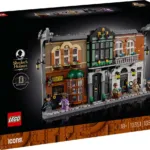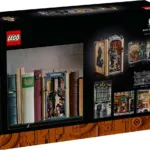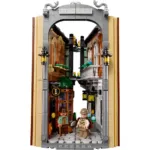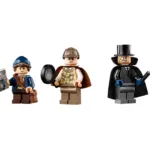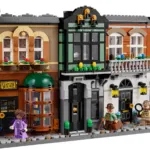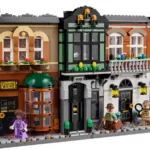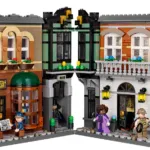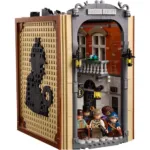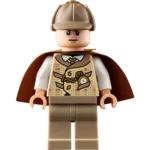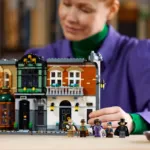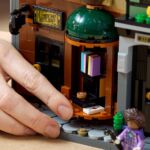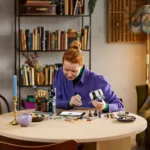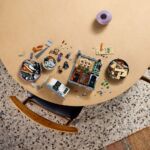By Barry Kay (SAFOLs Brick Boss, CapeLUG Member, Batman … Ssshhhh!)


LEGO® continues to bridge the gap between brick building and literature with the release of the Sherlock Holmes: Book Nook (10351) – a strikingly thematic set that merges architectural detail, storytelling, and compact display functionality. With 1,395 pieces and five unique minifigures, this 18+ set brings to life the moody alleyways and intellectual charm of Victorian London.
📚 Concept & Display Appeal
The Sherlock Holmes Book Nook is designed not just as a set to build and admire, but also as a functional piece of shelf décor. In its “closed” form, the build mimics the shape of a thick, hardcover book—making it ideal to tuck between actual books on a shelf. The front “cover” features a brick-built silhouette of Sherlock Holmes, complete with his iconic deerstalker hat and pipe, all rendered in a stylish two-tone mosaic effect.
Once opened, however, the Book Nook transforms into a three-dimensional Victorian scene. It unfolds into a three-panel diorama that captures the spirit of London’s Baker Street. This dual-purpose concept is unique for LEGO®: it merges creative storytelling with practical display use, catering especially to adult builders and collectors.

🧱 Build Structure and Techniques
At its core, this set is all about modular-style architecture within a bookend-sized footprint. It doesn’t rely heavily on Technic elements, but it does showcase a satisfying array of classic and modern building methods.
Hinged Structure
The build is split into three hinged sections: the left side features a storefront façade, the middle section houses the famous 221B address, and the rightmost panel contains Sherlock’s study interior. Each panel is hinged with standard LEGO® hinge bricks and rotates inward or outward depending on display preference. The hinge mechanism in the middle adds playability and customization to how the scene unfolds.
Use of SNOT Techniques
Although the majority of the structure is traditional brick-on-brick, Studs Not On Top (SNOT) techniques are subtly employed, particularly in areas like window framing, signage, and decorative wall trims. These help achieve more refined architectural shapes and compact detailing.
Gearing and Motion Features
A clever gear mechanism is embedded behind the center façade. Turning a discrete dial near the base of the build causes the front door to rise, revealing a secret compartment where Professor Moriarty is lurking. This functional element adds a layer of mystery and interaction to an otherwise static build.
Depth and Perspective
To simulate urban depth in such a narrow space, the set uses forced perspective tricks. Details become more compressed and simplified the deeper they go into the scene, mimicking distance. For example, cobblestone pathways taper in scale, and wall textures shift from layered bricks to flat tiles toward the back of the alley. This gives the illusion of a larger world within a small volume.

🏛️ Scene Breakdown
Each section of the build plays a distinct role in storytelling.
Left Section: The Bookshop Façade
This portion represents a quaint London bookstore. Its most prominent feature is a protruding bay window built with transparent panels, which can be gently rotated to give a peek inside. Above the window, a printed sign adds authenticity, while the storefront steps and lanterns below provide visual balance. The build here is compact but richly textured, using dark tan, nougat, and brown elements.
Middle Section: 221B Baker Street & Secret Lair
This central structure is the star of the set. The outer wall includes traditional British architecture—arched windows, gas lamps, and a numbered address tile. But the real highlight is the hidden play feature: turning a knob reveals the criminal mastermind, Moriarty, hiding behind a rising doorway. This sequence is controlled with an internal gear rack system, concealed within the base. The door opens cleanly thanks to smooth tiles and minimal friction, making it an engaging mechanical centrepiece.
Right Section: Sherlock Holmes’ Study
Inside the final panel is Sherlock’s study, a small but densely detailed room. Built using shallow depth but full vertical walls, this section includes a fireplace with a chimney stack, a violin resting on a wall-mounted rack, and an evidence board filled with clues. A stickered “Reichenbach Falls” painting nods to Holmes’ famous adventures. The study’s front wall opens outward like a cabinet door, allowing full access for posing minifigures or inspecting details.

🧍 Minifigures and Accessories
The set includes five highly detailed minifigures, each with exclusive printing and accessories that contribute to the narrative. (In order as per the image below)
- Dr. John Watson: Dressed in formal Victorian attire, Watson carries a cane and medical satchel. His inclusion reinforces the duo’s iconic partnership.
- The Baker Street Irregular: Represented as a newspaper boy, this character holds a printed paper tile and wears a brown cap. He adds a street-level perspective to the scene, rounding out the ensemble.
- Sherlock Holmes: Sporting his unmistakable deerstalker hat and cape, Sherlock comes equipped with a magnifying glass and printed waistcoat. His face features a serious expression, fitting for the cerebral detective.
- Professor Moriarty: The villain is sharply dressed in a pinstripe suit and top hat. He also features a dual-sided cape and facial expression that leans toward theatrical mischief.
- Irene Adler: Wearing a deep purple gown with subtle gold detailing, Adler is armed with an umbrella and confident smirk. Her torso and skirt are printed to resemble layered Victorian fashion.
The minifigs are diverse and expressive, with dual-sided head prints and detailed torso/back printing. While the space within the diorama limits how many can be actively displayed at once, they’re perfect for storytelling and rotation depending on your preferred narrative.

🪟 Visual Design & Colour Palette
A muted and cohesive colour scheme helps this set feel authentically Victorian. Shades like dark tan, reddish brown, dark green, and black dominate the structure, providing a realistic backdrop. Contrasting lighter elements like sand green and pearl gold are used sparingly for highlights, creating a moody but readable build.
Interior lighting isn’t included, but the layout lends itself well to aftermarket lighting kits. Trans-clear panels in the windows and openings in the roof would allow LED elements to shine through beautifully – especially helpful if the nook is placed between books in a dim room.
⚙️ Playability & Modularity
Although the set is clearly designed for display, it contains enough interactive elements to warrant much playability:
- The rotating shop window and movable front door provide physical engagement.
- Hinged panels offer multiple display modes – either folded shut to resemble a single “book,” or fully expanded to act as a small vignette.
- The Sherlock study includes enough open studs and modular floor elements for users to pose or swap out minifigures.
This makes the set more than just a shelf ornament. It’s a modular, interactive tribute to classic detective fiction – offering builders the chance to create, customize, and role-play.
🎨 Stickers and Printed Elements
The set includes a mix of printed tiles and stickers. While most major signage like the 221B number plate and newspaper are printed, other interior decorations such as paintings, maps, and clues are stickered. These add flavour to the scene but do require careful alignment for best results.
One could argue that full printing would elevate the premium feel of the set, but the stickers are high-quality and thematically appropriate.
🧩 Building Experience
The instruction booklet is well-paced, with logical sub-assemblies breaking the build into digestible sessions. The process is engaging for intermediate to advanced builders, thanks to its combination of standard architectural techniques and small mechanical functions.
There’s a strong sense of progression: starting with a flat book-like base, slowly layering upward with intricate walls and decorative façades. While no single portion of the build is overly complex, the satisfaction comes from seeing how small scenes come together into a unified, immersive environment.
✅ Pros and Cons
Pros:
- Unique folding book-nook format
- Excellent character selection
- Clever play features like the gear-operated door
- Detailed interiors and exteriors
- Perfect for shelf display and bookcases
Cons:
- Rear of the build is mostly flat and unadorned
- Stickers instead of all printed pieces
- Limited interior space for minifigure posing
- No included lighting, which would enhance display value
🧠 Final Thoughts
The LEGO® 10351 Sherlock Holmes: Book Nook is a charming and imaginative departure from traditional display models. Blending literary homage, Victorian street architecture, and clever mechanical play, it presents an innovative way for adult builders to combine their love of books, mysteries, and LEGO®.
While not overflowing with advanced techniques or complexity, the set delivers a uniquely satisfying build – particularly for fans of Sherlock Holmes or atmospheric builds. It offers a touch of storytelling magic that is rare in more utilitarian or modern-style LEGO® sets.
For those seeking a visually compelling, narrative-rich model that fits neatly into a bookshelf and doubles as décor, this Book Nook is a case worth cracking. It’s a strong debut for what may become a broader line of LEGO® book-nook-style builds—and one that feels right at home among both books and bricks.


